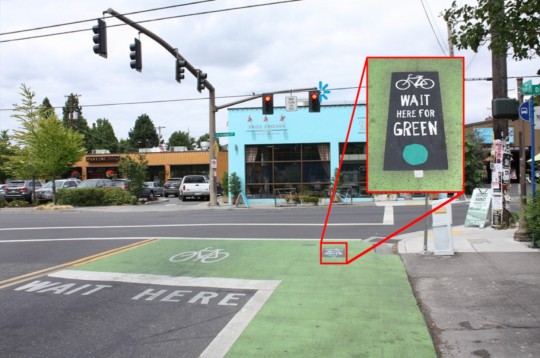The City of Portland wants you to get more green lights when cycling around the city and now’s your chance to help them do it.
We’ve teamed up with the Portland Bureau of Transportation* (PBOT) to learn more about what you currently do to get green lights and how the city can make it even easier for you in the future. In this post we’ll share some background and then we want to hear from you: Keep in mind, your comments will be closely monitored by us and engineers at the bureau’s Traffic Signal Division. Our goal is to get input from as many people as possible.
We’re going to ask you about two things: pavement markings and a tiny blue light. We’ll start with pavement markings…
Some of you know that there are sensors below the pavement at traffic signals in the city. Traffic signals are either constantly changing on a fixed timer or they change based on whether something or someone is detected. These “inductive loop detectors” work well (read our Bike Science article to learn how they work), but the challenge is you’ve got to know where to wait with your bike in order to trigger the sensors. Wait a little bit off the loop and the signal won’t know you’re there.
To make things easier, PBOT has put markings (like the ones above) on the pavement. If you roll your wheel over them (using the vertical bar as a guide), the signal will know you’re on a bike and you’ll get a green light.
Why is this so important? Getting a green promptly makes biking more efficient and convenient. And research shows that when signals don’t detect people on bikes they’re much more likely to roll through on a red. That’s not an ideal situation for anyone (especially our friends at the Portland Police Bureau). So, the more people that trigger these sensors, the better.
PBOT’s goal is to make these pavement markings as intuitive as possible. That’s where you come in: the City of Portland is considering a change to the standard marking they use; but they need your input before making that investment.
Advertisement
While the standard marking is a nice gesture, it’s fairly ambiguous. Is it showing a safe place to ride? Is it a bikeway route marking? It depends a lot on location, but research shows that only 25 percent of riders actually use the standard marking; and less than half know what it means. This has led PBOT’s signal engineers to reconsider the standard design.
PBOT has done some initial research into which marking increases the amount of people who wait in the right place. A recent field survey presented riders with the five markings below. Each person was asked what they thought the marking was for and which one conveyed that purpose most clearly:
The winner? A modified version of the marking in the middle of the bottom row. The City of Portland has taken the main elements of that marking and adapted it as we’ve shown in the images below. Before they install hundreds of more of these throughout the city, PBOT wants to know what you think about it…
Another way PBOT helps you get the green is with cool little blue lights mounted near signal heads (see image below). We reported about these in 2010 when the first one was installed. The idea is that, instead of making you push a “beg button” over on the sidewalk, a blue “detector confirmation light” comes on automatically as you roll up to the intersection. The city has installed a few of these already; but before they install more they’d like to know if 1) you’ve noticed them and 2) if you have any idea what the blue light means.
OK. We’re almost done. Here’s a recap of the questions we need need you to answer (tip: copy/paste these into the comment box):
- 1) Are you from the Portland metro area? (We want to hear from everyone, we’re just curious.)
- 2) Did you know how to get a green before reading this article? (Be honest!)
- 3) Imagine yourself rolling up to a signalized intersection. What does the pavement marking (as shown in Figure 1 above) communicate to you?
- 4) Would you be more likely to wait in the correct spot for a green light if an intersection had this marking on the pavement? (If so, do you think PBOT should add this marking to more intersections?)
- 5) Have you noticed the blue indicator light on the signals at SE 21st and Division and NE Tillamook and Martin Luther King Jr. Blvd? If so, did you know what it was for before you read this post?
Thank you for answering these questions.
As always, feel free to share other thoughts on this topic. Our goal is to help the City make an informed choice about how to make signals work better for cycling. The more people who respond the better, so please share this with your friends (we’ll track responses via our Facebook, Twitter, and Instagram accounts too).
Stay tuned as we report on any developments.
*This is an official partnership between BikePortland and the Portland Bureau of Transportation. The city has entered into a paid contract with us in order to solicit feedback directly from our audience (a.k.a. people who ride bikes).
— Jonathan Maus, (503) 706-8804 – jonathan@bikeportland.org
BikePortland can’t survive without paid subscribers. Please sign up today.








